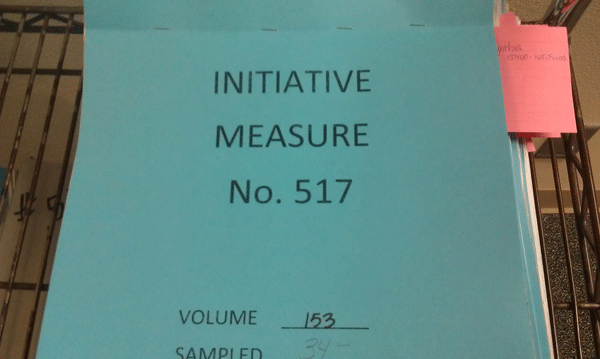I-517 signature check completed
The first of two initiatives to the Legislature has cleared a key hurdle after a signature check showed it has a sufficient number of signatures to advance to the Legislature for consideration. The Secretary of State’s Election Division finished the review of Tim Eyman’s latest initiative, I-517, Wednesday.
Dubbed the “Protect the Initiative Act,” Eyman’s ballot offering would set penalties for interfering with or retaliating against signature-gatherers and petition-signers; require that all measures receiving sufficient signatures appear on the ballot; and extend time for gathering initiative petition signatures from six months to one year.
The Elections Division plans to begin signature checking for I-522, the second of two initiatives to the Legislature, later on Wednesday. I-522, sponsored by Chris McManus, deals with labeling of most raw farm commodities, processed foods and seeds if genetically engineered.
In order for an initiative to the Legislature to be certified, it must have at least 241,153 valid signatures of registered voters – or 8 percent of the total votes cast for governor in the 2008 election. (Starting this year for the next four years, initiatives filed with the Elections Division will need at least 246,372 valid signatures to be certified – this updated number reflects the 2012 governor’s election.)
It was determined that Initiative 517 sponsors turned in nearly 347,000 signatures, enough for a 3 percent random sample check to be done instead of a full check, which would have taken at least two months. The sample check took just over a week. The Elections Division is required to complete a signature check on an initiative to the Legislature within 40 days of when signatures were submitted. Out of a random sample of 10,606 signatures for I-517, 9,122 were valid, 1,459 were invalid and there were 25 pairs of duplicate signatures. The signature check results were certified Wednesday afternoon.
Legislators have three options for each initiative sent their way: pass it into law as is, not take action, which would result in it going to the November ballot for a public vote, or send it and a legislative alternative to the ballot and let voters decide which, if either, they want to support. The typical initiative to the Legislature takes the second path, going on the General Election ballot. One or both chambers may hold public hearings on either or both initiatives.
The Office of Secretary of State keeps a firm position of neutrality in the initiative process. New Secretary of State Kim Wyman held a meeting for members of the press last week and reiterated her office’s position of neutrality saying she, “really respects the initiative process” and “will let the Legislature decide [the fate of any initiative sent there.]”
